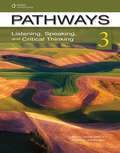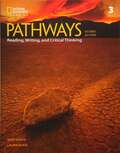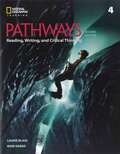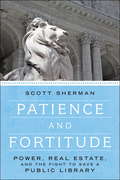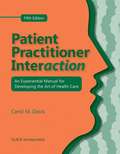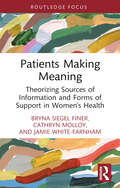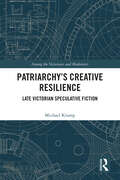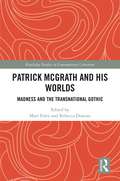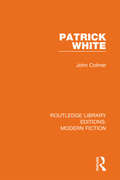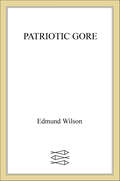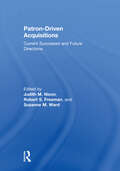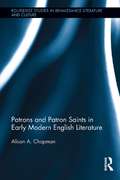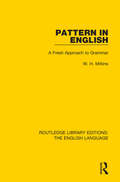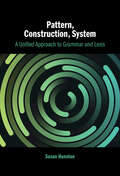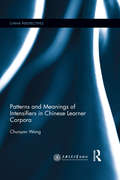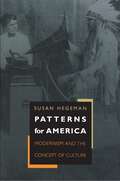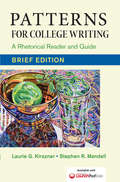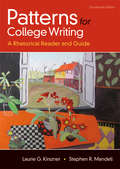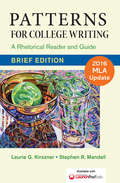- Table View
- List View
Pathways: Listening, Speaking, and Critical Thinking 3
by Kristin L. Johannsen Rebecca Tarver Chase Milada Broukal Paul MacintyreThis is the new five-level academic skills series that features reading & writing and listening & speaking strands to help learners develop the language skills needed to achieve academic success.
Pathways: Reading, Writing, And Critical Thinking 3
by Mari Vargo Laurie BlassPathways, Second Edition, is a global, five-level academic English program. Carefully-guided lessons develop the language skills, critical thinking, and learning strategies required for academic success. Using authentic and relevant content from National Geographic, including video, charts, and other infographics, Pathways prepares students to work effectively and confidently in an academic environment.
Pathways: Reading, Writing, and Critical Thinking 2
by Mari Vargo Laurie Blass Keith S. FolseGrade 6, Grade 7, Grade 8, Grade 9 textbook
Pathways: Reading, Writing, and Critical Thinking 4
by Mari Vargo Laurie BlassPathways, Second Edition, is a global, five-level academic English program. Carefully-guided lessons develop the language skills, critical thinking, and learning strategies required for academic success. Using authentic and relevant content from National Geographic, including video, charts, and other infographics, Pathways prepares students to work effectively and confidently in an academic environment.
Pathways: Scenarios For Sentence And Paragraph Writing
by Kathleen T. McWhorterA lively, integrated approach that emphasizes the connection of the reading and writing processes Pathways: Scenarios for Paragraph and Sentence Writing, Fourth Edition teaches fundamental sentence and paragraph writing skills by engaging student interest, maintaining a focus on expressing ideas rather than on following rules. Students learn grammar in the context of the “whole paper.” Seven of the 17 chapters deal with grammar topics; in these chapters, students examine student essays, read and respond to ideas, and write and revise paragraphs. In Parts II through IV, students apply what they have learned about sentence-level correctness to their own writing as they explore logical paragraph development and organization of ideas. The last two chapters introduce essay writing, enabling students to accelerate from paragraphs to essays, with the goal of achieving stronger, more fully developed writing skills.
Patience & Sarah
by Emma Donoghue Isabel MillerSet in the nineteenth century, Isabel Miller’s classic lesbian novel traces the relationship between Patience White, an educated painter, and Sarah Dowling, a cross-dressing farmer, whose romantic bond does not sit well with the puritanical New England farming community in which they live. They choose to live together and love each other freely, even though they know of no precedents for their relationship; they must trust their own instincts and see beyond the disdain of their neighbors. Ultimately, they are forced to make life-changing decisions that depend on their courage and their commitment to one another.<P> First self-published in 1969 in an edition of one thousand copies, the author hand-sold the book on New York street corners; it garnered increasing attention to the point of receiving the American Library Association’s first Gay Book Award in 1971. McGraw-Hill’s version of the book a year later brought it to mainstream bookstores across the country.<P> Patience & Sarah is a historical romance whose drama was a touchstone for the burgeoning gay and women’s activism of the late 1960s and early 1970s. It celebrates the joys of an uninhibited love between two strong women with a confident defiance that remains relevant today.
Patience and Fortitude
by Scott ShermanA riveting investigation of a beloved library caught in the crosshairs of real estate, power, and the people's interests--by the reporter who broke the story In a series of cover stories for The Nation magazine, journalist Scott Sherman uncovered the ways in which Wall Street logic almost took down one of New York City's most beloved and iconic institutions: the New York Public Library. In the years preceding the 2008 financial crisis, the library's leaders forged an audacious plan to sell off multiple branch libraries, mutilate a historic building, and send millions of books to a storage facility in New Jersey. Scholars, researchers, and readers would be out of luck, but real estate developers and New York's Mayor Bloomberg would get what they wanted. But when the story broke, the people fought back, as famous writers, professors, and citizens' groups came together to defend a national treasure. Rich with revealing interviews with key figures, Patience and Fortitude is at once a hugely readable history of the library's secret plans, and a stirring account of a rare triumph against the forces of money and power.From the Hardcover edition.
Patient Practitioner Interaction: An Experiential Manual for Developing the Art of Health Care
by Carol M. DavisOver 20 years ago, Dr. Carol M. Davis created the path for teaching health care professionals how to develop self-awareness and communication skills critical to providing ethical, compassionate, and professional treatment and care to their patients. That path is Patient Practitioner Interaction: An Experiential Manual for Developing the Art of Health Care, now in its Fifth Edition. While the ways of communication have evolved over the last 23 years, the face-to-face role of the practitioner and patient has not. With technology having a large presence in health care, the personal interaction and comfort provided by the health care professional serves an even more important purpose in facilitating healing with therapeutic presence. Patient Practitioner Interaction, Fifth Edition begins with chapters that assist students in self-awareness and understanding of their own history in developing their values and communication skills. This then guides the student into learning how to differentiate personal values from professional values. In the remaining chapters, Dr. Carol M. Davis and her contributors take Patient Practitioner Interaction, Fifth Edition into the heart of the text: teaching actual skill development in communicating with patients, as well as skills in diagnosis, prognosis, and treatment. The updated exercises at the end of each chapter encourage an essential element in the inculcation of these fundamental skills -- reflection and personalization of the material to ones own story. New in the Fifth Edition: * A new chapter on communicating about spirituality that teaches health care professionals to better assess the needs of patients and families dealing with hope, faith, and despair * New material on communicating in the information age * A reorganization of the chapters, contemporary terminology, and references * New and updated exercises at the end of each chapter in the book.
Patient-Centred Translation and Communication (Translation Practices Explained)
by Vicent Montalt-Resurrecció Isabel García-Izquierdo Ana Muñoz-MiquelIn response to the growing importance and spread of patient-centred care, the need to empower patients and the trend towards democratising specialised knowledge in health care, this book puts patients centre stage and provides concepts, methods and learning materials to enhance effective communication with patients and relatives in health care settings.Opening chapters establish the conceptual and methodological framework needed to understand patient-centredness, the crucial role of context and culture, the range of communicative situations and text genres involved and the diversity of modes, formats and media in which patient-centred translation and communication take place. Subsequent chapters raise awareness of the importance of carefully defining the target audience and producing understandable and empathetic messages and provide analytical tools for making decisions in these three key areas. The concluding chapter offers avenues for research in patient-centred translation and communication with the hope of bridging the gap between practice and research and advancing this growing field of inquiry.Including activities, resources, summaries, further reading and pointers to further research in each chapter, this is the essential guide for all translators and interpreters, students and professionals working in this area of translation studies, health care and communication studies.
Patients Making Meaning: Theorizing Sources of Information and Forms of Support in Women’s Health (Routledge Studies in Rhetoric and Communication)
by Jamie White-Farnham Bryna Siegel Finer Cathryn MolloyThis book explores how women make meaning at various health flashpoints in their lives, overcoming fear, anxiety, and anger to draw upon self-advocacy, research, and crucial decision-making. Combining focus group research, content analysis, autoethnography, and textual inquiry, the book argues that the making and remaking of what we call “patient epistemologies” is a continual process wherein a health flashpoint—sometimes a new diagnosis, sometimes a reoccurrence or worsening of an existing condition or the progression of a natural process—can cause an individual to be thrust into a discourse community that was not of their own choosing. This study will interest students and scholars of health communication, rhetoric of health and medicine, women’s studies, public health, healthcare policy, philosophy of medicine, medical sociology, and medical humanities.
Patients Making Meaning: Theorizing Sources of Information and Forms of Support in Women’s Health (Routledge Studies in Rhetoric and Communication)
by Jamie White-Farnham Bryna Siegel Finer Cathryn MolloyThis book explores how women make meaning at various health flashpoints in their lives, overcoming fear, anxiety, and anger to draw upon self-advocacy, research, and crucial decision-making.Combining focus group research, content analysis, autoethnography, and textual inquiry, the book argues that the making and remaking of what we call “patient epistemologies” is a continual process wherein a health flashpoint—sometimes a new diagnosis, sometimes a reoccurrence or worsening of an existing condition or the progression of a natural process—can cause an individual to be thrust into a discourse community that was not of their own choosing.This study will interest students and scholars of health communication, rhetoric of health and medicine, women’s studies, public health, healthcare policy, philosophy of medicine, medical sociology, and medical humanities.
Patriarchy’s Creative Resilience: Late Victorian Speculative Fiction (Among the Victorians and Modernists)
by Michael KrampPatriarchy’s Creative Resilience explores the disturbing sustainability of White male supremacy. Kramp traces an imaginative failure and an imaginative success; his focus on British speculative fiction published between 1870 and 1900 demonstrates how even this elastic and wildly inventive literary form remains incapable of promoting non- patriarchal masculinity, and he attributes this inability to the creative resiliency of white male supremacy. He demonstrates the inventive use of diverse resources that we frequently view as custom or uncomplicated history and a versatility that we often dismiss as sheer power. He draws on an archive of late nineteenth- century speculative fiction to detail a versatile patriarchal toolbox, including hegemonic masculinity, control of dangerous women, hyperbolic and sentimental performances of male sovereignty, and reversions to authoritarian, at times violent conduct. He also considers how the classic military strategy of dividing to conquer undergirds all these tactics, inhibiting our creating energies and dynamic collaborations. Various chapters demonstrate the enterprise, ingenuity, and adaptability of patriarchy to refashion and rejustify normalized systems of oppression. While scholars have consistently identified moments and agents of resistance to patriarchal structures by highlighting creativity, resiliency, and resourcefulness, Kramp’s project reveals how patriarchy itself is creative, resilient, and resourceful.
Patrick McGrath and His Worlds: Madness and the Transnational Gothic (Routledge Studies in Contemporary Literature #39)
by Matt Foley Rebecca DuncanFollowing the publication of Ghost Town (2005), a complex, globally conscious genealogy of millennial Manhattan, McGrath’s transnational status as an English author resident in New York, his pointed manipulation of British and American contexts, and his clear apprehension of imperial legacies have all come into sharper focus. By bringing together readings cognizant of this transnational and historical sensitivity with those that build on existing studies of McGrath’s engagements with the gothic and madness, Patrick McGrath and his Worlds sheds new light on an author whose imagined realities reflect the anxieties, pathologies, and power dynamics of our contemporary world order. McGrath’s fiction has been noted as parodic (The Grotesque, 1989), psychologically disturbing (Spider, 1990), and darkly sexual (Asylum, 1996). Throughout, his corpus is characterized by a preoccupation with madness and its institutions and by a nuanced relationship to the gothic. With its international range of contributors, and including a new interview with McGrath himself, this book opens up hitherto underexplored theoretical perspectives on the key concerns of McGrath’s ouevre, moving conversations around McGrath’s work decisively forward. Offering the first sustained exploration of his fiction’s transnational and world-historical dimensions, Patrick McGrath and his Worlds seeks to situate, reflect upon, and interrogate McGrath’s role as a key voice in Anglophone letters in our millennial global moment.
Patrick White (Routledge Library Editions: Modern Fiction #9)
by John ColmerPatrick White is a giant among the moderns. His massive novels, which chart the lonely paths to truth, challenge orthodox notions about fiction and reality. He has created a wholly new kind of prose to embody his prophetic visions of truth and his fierce denunciations of modern society. Originally published in 1984, John Colmer’s study of the Nobel Prize winning Australian novelist was the first to survey all his published works. It differs from earlier studies in using fresh autobiographical material, in revealing the links between the plays and the fiction and in stressing White’s vision of duality rather than his much praised affirmations of harmony. Where previous studies have been exegetical this one is also evaluative. It illustrates the process by which White has come to recognize the necessity for the reintegration of the alienated visionary into society.
Patriotic Gore: Studies In The Literature Of The American Civil War
by Edmund WilsonThe classic study of literature from the Civil War, featuring critical profiles of notable figures who captured its grim reality and profound meaning.In his introduction to Patriotic Gore, Edmund Wilson asks, “Has there ever been another historical crisis of the magnitude of 1861–1865 in which so many people were so articulate?” Regarded by many as Wilson’s greatest book, Patriotic Gore more than proves the point, brilliantly portraying the vast political, spiritual, and material crisis of the Civil War as reflected in the lives and writings of some thirty representative Americans.Figures discussed include Harriet Beecher Stowe, Abraham Lincoln, Ulysses S. Grant, William Tecumseh Sherman, and Oliver Wendell Holmes, among many others.
Patron-Driven Acquisitions: Current Successes and Future Directions
by Judith M. Nixon Robert S. Freeman Suzanne M. WardFor over a decade, some academic libraries have been purchasing, rather than borrowing, recently published books requested by their patrons through interlibrary loan. These books had one circulation guaranteed and so appealed to librarians who were concerned about the large percentage of books selected and purchased by librarians but never checked out by their patrons. Early assessments of the projects indicated that patrons selected quality books that in many cases were cross disciplinary and covered emerging areas of scholarly interest. However, now we have a significant database of the ILL purchase records to compare these titles with books selected through normal methods. The projects described in this book present a powerful argument for involving patrons in the book selection process.This book looks at patron-driven acquisitions for printed books at Purdue University, the University of Nebraska-Lincoln and the University of Illinois, as well as exploring new programs that allow patrons to select e-books or participate in other innovative ways in building the library collections.This book was published as a special issue of Collection Management.
Patrons and Patron Saints in Early Modern English Literature (Routledge Studies in Renaissance Literature and Culture)
by Alison ChapmanThis book visits the fact that, in the pre-modern world, saints and lords served structurally similar roles, acting as patrons to those beneath them on the spiritual or social ladder with the word "patron" used to designate both types of elite sponsor. Chapman argues that this elision of patron saints and patron lords remained a distinctive feature of the early modern English imagination and that it is central to some of the key works of literature in the period. Writers like Jonson, Shakespeare, Spenser, Drayton, Donne and, Milton all use medieval patron saints in order to represent and to challenge early modern ideas of patronage -- not just patronage in the narrow sense of the immediate economic relations obtaining between client and sponsor, but also patronage as a society-wide system of obligation and reward that itself crystallized a whole culture’s assumptions about order and degree. The works studied in this book -- ranging from Shakespeare’s 2 Henry VI, written early in the 1590s, to Milton’s Masque Performed at Ludlow Castle, written in 1634 -- are patronage works, either aimed at a specific patron or showing a keen awareness of the larger patronage system. This volume challenges the idea that the early modern world had shrugged off its own medieval past, instead arguing that Protestant writers in the period were actively using the medieval Catholic ideal of the saint as a means to represent contemporary systems of hierarchy and dependence. Saints had been the ideal -- and idealized -- patrons of the medieval world and remained so for early modern English recusants. As a result, their legends and iconographies provided early modern Protestant authors with the perfect tool for thinking about the urgent and complex question of who owed allegiance to whom in a rapidly changing world.
Pattern in English: A Fresh Approach to Grammar (Routledge Library Editions: The English Language #18)
by W. H. MittinsThis book, first published in 1950, is a collection of what the author felt to be the minimum of English grammar relevant to efficient communication in language. The scope of this title was determined by collecting from children’s writings examples of common faults and weaknesses, and it is through these texts that certain concepts emerged as fundamental, including predication, word-order, proximity, equivalents, variety and repetition. Pattern in English will be of interest to students of English language.
Pattern, Construction, System: A Unified Approach to Grammar and Lexis
by Susan HunstonConstruction Grammar and Systemic Functional Grammar take different approaches to the study of lexico-grammar, based on language as a cognitive and as a social phenomenon respectively. This is the first book to bring the two approaches together, using corpus-based Pattern Grammar as an underlying descriptive framework, in order to present a comprehensive and original treatment of verb-based patterns in English. It describes in detail two processes: deriving over 800 verb argument constructions from 50 verb complementation patterns; and using those constructions to populate systemic networks based on 9 semantic fields. The result is an approach to the lexis and grammar of English that unifies disparate theories, finding synergies between them and offering a challenge to each. Pattern Grammar, Construction Grammar and Systemic-Functional Grammar are introduced in an accessible way, making each approach accessible to readers from other backgrounds. This title is also available as open access on Cambridge Core.
Patterns and Coincidences: A Sequel to "All Is But a Beginning"
by John G. NeihardtThis volume is a continuation of the autobiography of John G. Neihardt All Is But a Beginning offering a final glimpse into his fascinating life. Covering the years 1901-1908, he weaves a mosaic of personal fulfillment, joy and sorrow, reflecting on the successes and failures he experienced during his "mature" years. As only he could, Neihardt shares a mingling of romantic anecdotes alive with names and faces he sought out or fought for along the way.Writing with warmth and sensitivity, the late Poet Laureate of Nebraska tells of his early newspaper days, his struggle to write poetry, his family, his encounters with nature, his relationships with Indians, and the various people who, whether met once or often, had a profound effect on his life. Using a conversational style, the author does not present episodes in chronological order. Rather he begins to elaborate on one memorable experience, then quickly draws out, without warning, another one that occurred years later, tying them into a pattern or coincidence.The book's Epilogue is written by Neihardt's daughter, Hilda Neihardt Petri. Summarizing her father's visions, daydreams, and philosophy, she movingly concludes that with his death on 3 November 1973 Neihardt's "great adventure had begun."The late John G. Neihardt is best remembered as an authority on the traditions and customs of the Sioux Indians. Neihardt, named Poet Laureate of Nebraska in 1921 and Prairie Poet Laureate of America in 1968, was literary editor of the St. Louis Post-Dispatch from 1926 to 1938 and poet in residence and lecturer in English at the University of Missouri-Columbia from 1949 to 1965. The author of some twenty-five volumes of poetry, fiction, and philosophy, his works include Black Elk Speaks, Lyric and Dramatic Poems, and A Cycle of the West.
Patterns and Meanings of Intensifiers in Chinese Learner Corpora (China Perspectives)
by Chunyan WangIntensification plays a major role in spoken and written interaction, enabling the writer or speaker to express different levels of commitment. This book explores the patterns and meanings of intensifiers in Chinese learner English by ways of comparison with native English. The study is conducted within the theoretical framework of Firthian contextual theory of meaning, Sinclairian model of Extended Units of Meaning (EUM) and Hunston's pattern grammar. The method of contrastive inter-language analysis (CIA) is adopted and the intensifier collocations in learner English and native English are explored by means of quantitative and qualitative analyses of corpora data. This book is the first attempt to investigate the patterning and meaning features of intensifiers systematically with the corpora data in Chinese learner English. Readers will obtain a relatively complete picture of how Chinese learners use intensifiers to realize their attitudinal meanings.
Patterns for America: Modernism and the Concept of Culture
by Susan HegemanIn recent decades, historians and social theorists have given much thought to the concept of "culture," its origins in Western thought, and its usefulness for social analysis. In this book, Susan Hegeman focuses on the term's history in the United States in the first half of the twentieth century. She shows how, during this period, the term "culture" changed from being a technical term associated primarily with anthropology into a term of popular usage. She shows the connections between this movement of "culture" into the mainstream and the emergence of a distinctive "American culture," with its own patterns, values, and beliefs. Hegeman points to the significant similarities between the conceptions of culture produced by anthropologists Franz Boas, Edward Sapir, Ruth Benedict, and Margaret Mead, and a diversity of other intellectuals, including Randolph Bourne, Van Wyck Brooks, Waldo Frank, and Dwight Macdonald. Hegeman reveals how relativist anthropological ideas of human culture--which stressed the distance between modern centers and "primitive" peripheries--came into alliance with the evaluating judgments of artists and critics. This anthropological conception provided a spatial awareness that helped develop the notion of a specifically American "culture." She also shows the connections between this new view of "culture" and the artistic work of the period by, among others, Sherwood Anderson, Jean Toomer, Thomas Hart Benton, Nathanael West, and James Agee and depicts in a new way the richness and complexity of the modernist milieu in the United States.
Patterns for College Writing
by Laurie G. Kirszner Stephen R. MandellTHIS TITLE HAS BEEN UPDATED TO REFLECT THE 2016 MLA UPDATES! Our editorial team has updated this text based on content from The MLA Handbook, 8th Edition. Browse our catalog or contact your representative for a full listing of updated titles and packages, or to request a custom ISBN. Laurie Kirszner and Stephen Mandell, authors with thirty years of experience teaching college writing, know what works in the classroom and have a knack for picking just the right readings. In Patterns for College Writing, they provide students with exemplary rhetorical models and instructors with class-tested selections that balance classic and contemporary essays. Along with more examples of student writing than any other reader, Patterns has the most comprehensive coverage of active reading, research, and the writing process, with a five-chapter mini-rhetoric; the clearest explanations of the patterns of development; the most thorough apparatus of any rhetorical reader; and the most comprehensive coverage of argumentative writing--all reasons why Patterns for College Writing is the best-selling reader in the country. And the new edition includes exciting new readings, images, and debate and casebook topics. Patterns is now available as a Bedford e-Book to Go and in a variety of formats that can be downloaded to a computer, tablet, or e-reader. And now with the new edition, you can meet students where they are: online. Our newest set of online materials, LaunchPad Solo, provides all the key tools and course-specific content that you need to teach your class. Get all our great course-specific materials in one fully customizable space online; then assign and mix our resources with yours.
Patterns for College Writing
by Laurie G. Kirszner Stephen R. MandellBestselling authors Laurie Kirszner and Stephen Mandell know what works in the classroom. In Patterns for College Writing, they provide students with exemplary rhetorical models and just the right balance of classic and contemporary essays. Patterns includes comprehensive coverage of active reading, research, and the writing process in a five-chapter mini-rhetoric. This is followed by clear and thorough explanations of the patterns of development with the most thorough apparatus of any rhetorical reader and an example of student writing for each pattern. Add to that the most comprehensive coverage of argumentative writing and you will see why Patterns for College Writing is the best-selling reader in the country. The new edition includes exciting new readings, images, and debate and casebook topics.
Patterns for College Writing 2016 MLA Update
by Laurie G. Kirszner Stephen R. MandellTHIS TITLE HAS BEEN UPDATED TO REFLECT THE 2016 MLA UPDATES! Our editorial team has updated this text based on content from The MLA Handbook, 8th Edition. Browse our catalog or contact your representative for a full listing of updated titles and packages, or to request a custom ISBN. Laurie Kirszner and Stephen Mandell, authors with thirty years of experience teaching college writing, know what works in the classroom and have a knack for picking just the right readings. In Patterns for College Writing, Brief Edition, they provide students with exemplary rhetorical models and instructors with class-tested selections that balance classic and contemporary essays. Along with more examples of student writing than any other reader, Patterns has the most comprehensive coverage of active reading, research, and the writing process, with a five-chapter mini-rhetoric; the clearest explanations of the patterns of development; the most thorough apparatus of any brief rhetorical reader; and the most comprehensive coverage of argumentative writing. And this new brief edition includes exciting new readings, images, and debate and casebook topics. Preface
